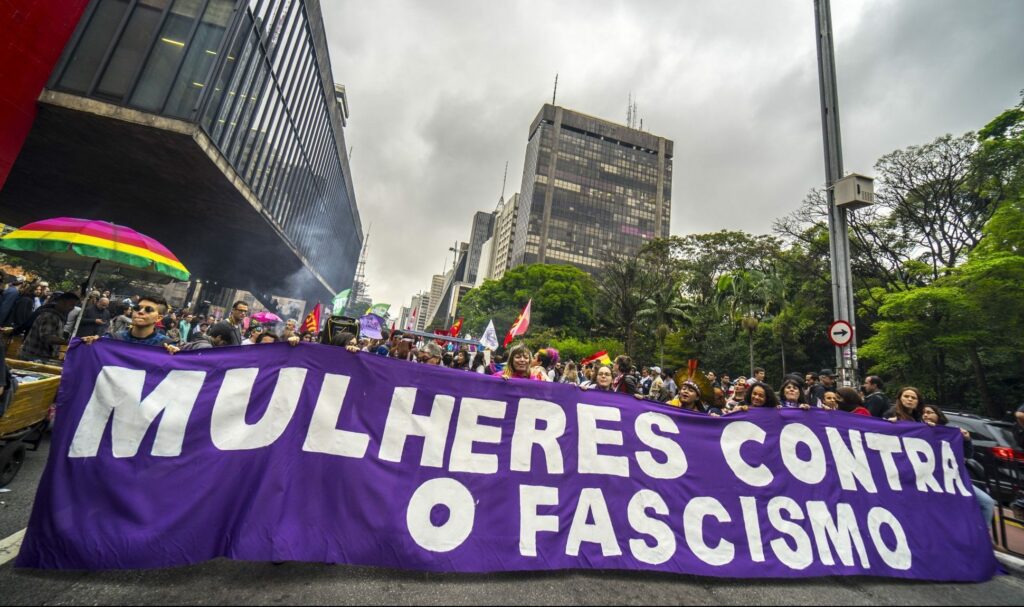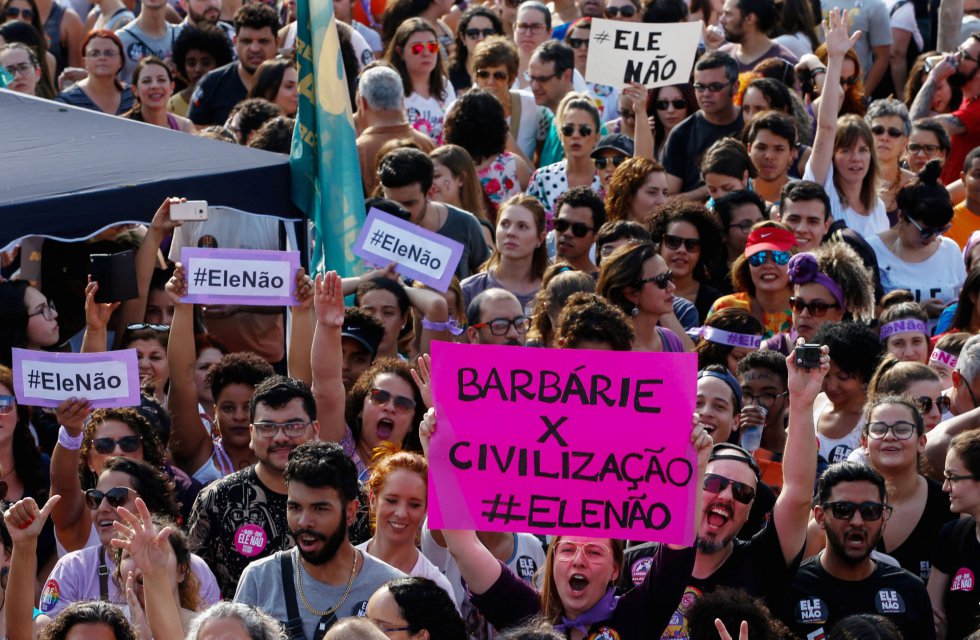Jair Bolsonaro’ s misogynistic, racist, and homophobic past statements have outraged many citizens, especially among minorities groups (Rossi, Carneiro & Gragnani, 2018). So much so that on the 29th of September 2018 protests led by women were occurring in various Brazilian cities and around the world against the candidacy of Jair Bolsonaro. The movement hoped to generate awareness and that the vote of women could really make the difference in the polls as women in Brazil represent 52% of the total electorate. The protests took place in many Brazilian capitals, such as Rio de Janeiro, São Paulo, Belo Horizonte, Brasília, Recife, Porto Alegre, Curitiba, and Salvador; whereas internationally in New York, Barcelona, Berlin, Lisbon, and Paris.

The manifestation had a lot of news coverage as it was the largest protest ever held by women in the country. The manifestation was organized on social media by a Facebook group called “United Women Against Bolsonaro” founded by Ludmilla Teixeira – 36 years old, advertising executive – to coordinate the acts against the presidential candidate (Philips, 2018). The page presented the manifestations as an act “Against the progress and strengthen of machismo, misogyny, homophobia, and other types of discrimination” (Veja Politica 29 Set. 2018). The manifestation was named after the hashtag #EleNão (#NotHim) created on the 12th of September by the “Feminist Movement in Repudiation of Bolsonaro.” Since then, the hashtag has been used on social networks, including by celebrities – national and international. Additionally, two days before the protests (27th of September), the group had shared its manifesto against the candidacy of Jair Bolsonaro; contextualizing and explaining the reasons for the protest (Brasil de Fato 27 Set. 2018). Lastly, it is important to mention that the group has been hacked several times, and since the 22nd of January 2019, the name of the group has changed to: “Mulheres Unidas Com o Brasil,” although the group description on Facebook continues the same.
Profile of the Participants
According to a survey based on interviews carried out by the Research Group on Public Policies for Access to Information at USP (University of São Paulo) the manifestation in the city of São Paulo was the biggest in the whole country. The survey revealed that 80 percent of its parts participants identified themselves as left-wing (de esquerda), 8 percent as center-left and only 1 percent as right-wing, the rest did not answer (Schreiber 2018). Additionally, 76 percent declared themselves as not conservative, 75 percent not anti-petista, and 70 percent feminist. Lastly, 31 percent declared to have a family income superior to five to ten minimum wages, and another 26 percent declared to earn more than 10 minimum wages. During the manifestation in different cities according to many journals and uploaded pictures it was possible to see flags and stickers promoting political parties and presidential candidates; including Fernando Haddad (Workers Party); Guilherme Boulos (Socialist and Free Party); Ciro Gomes (Workers Democratic Party); Manuela D’Avila (Communist Party of Brazil).
Women for #Ele sim
Two days after the manifestation a survey was published by IBOPE (Instituto Brasileiro de Opinião Pública e Estatística) concerning the ‘intentions to vote for Bolsonaro’ which had increased by 6 percent among women (Pierry, 2018). According to Marcio Coimbra – Brazilian political analyst – the movement did not help in altering ‘Bolsonarist’ votes because the manifestation was perceived as an alliance with the PT party the other left-wing parties (Pierry, 2018). Moreover, he commented that the findings of the Research Group on Public Policies for Access to Information at USP show a specific profile of protestors and many further studies can be done related to the outcomes of the protest #Ele Não. It can be argued that “gender equality has become politicized” as many other women, who directly rejected ‘the feminist agenda,’ were backing up the candidate Jair Bolsonaro (Watson, 2018). Many other events should be taken into account to understand the shift of women’s vote, as it is important to understand the reasons why Jair Bolsonaro was the choice for a substantial number of women.

Analysis: The Feminist Product of #EleNão
An analysis of two texts related to the manifestation #EleNão is conducted in this section. This is done in order to understand the discursive construction of the feminist identity by analyzing the ideological discourses in these texts. Indeed, Ideological Discourse Analysis is used in this chapter to find the key discursive constructions of identity. The text being analyzed is the manifesto proposed by the group “Women United Against Bolsonaro” which is representative of the protests and those who adhere the protests.
‘Manifesto Mulheres Unidas Contra Bolsonaro’
Themes, Topics, Context: The title of the manifesto that gave voice to millions of women in the manifestation #EleNão (Not Him) in Brazil is: “Manifesto das Mulheres Unidas Contra Bolsonaro” (Manifesto of United Women Against Bolsonaro). This title already conveys the idea of the main topic which is a critique to Bolsonaro’s discourses, that according to the manifesto, attacked the moral and democratic principles of the nation. Moreover, the main topic also concerns the resistance against gender and other minorities’ discriminations. The context in which the manifesto was written and then published was during the presidential campaign of 2018. The theme is mainly political and supportive of the fights against discrimination of minorities. While reading through the text it is also possible to indicate more political allegations which regularly relate to specific gender or minorities issues. The manifesto starts with the description of the in-group goals which focus on broad themes such as equality, freedom and the right to live with no violence or fear. Also it explains the motive behind their actions, that is: “[…] ameaça nossas conquistas e nossa já difícil existência.” The threat to an already ‘difficult existence’ shows the power-relations that are constructed in the manifesto, where women position themselves as less empowered than the ‘other.’ Moreover, the manifesto exposes a self- identity description entitled “Quem somos?” following, they refer to themselves as:
“Somos mulheres,milhões e diversas […] negras, brancas, indígenas. Trans e travestis. Somos LGBTs, amamos homens, mulheres ou ambos. Casadas e solteiras. Mães, filhas, avós. Somos trabalhadoras, donas de casa, estudantes, artistas, funcionárias públicas, pequenas empresárias, camelôs, sem teto, sem terra. Empregadas e desempregadas. Mulheres de diferentes religiões e sem religião”
“Who are we?” “We are women, millions and diverse […] black, white, indigenous, transgenders, we are LGBT, we love women, men or both. Married and single. Mothers, daughters, grandmothers. We are hardworking, housewives, students, artists, public servants, small business women, street vendors, homeless, landless. Employed and unemployed. Women of different religions and without religion.”

This self-description creates an image of multiple and dynamic identities; it expresses inclusivity and encompasses multiple opinions with regards to the understanding of the identity of its members. This type of inclusive discourse might be related to the understanding of multiple ‘othering’ referred by Hernández – Truyol in describing feminist identity in Latin America and in Brazil. Further, this manifesto embraces also other minority groups in its self-description, such as the LGBT community. The text also includes a description of the ‘other,’ namely Jair Bolsonaro. His description is a bound and short paragraph only stressing how he is no different than any other ‘old’ politician. Overall, it can be argued that the manifesto presents political implicatures, such as the idea that Bolsonaro’s voters are subscribing to his homophobic, racist, sexist and other narratives. Further, as previously mentioned, it is part of the ideological strategy to outline discourses according to the ‘ideological square format’ proposed by Van Dijk (Appendix 1).
Lexicons and Local Meanings: Other essential points to evaluate are local meanings and lexicons. The management of clarity and vagueness (level and precision) throughout the manifesto – when describing the in-group and out-group or when exposing events – is a crucial tool for the construction of rhetorical structures that persuade recipients to pay attention to specific meanings. Indeed, the self-description – previously analyzed – is more detailed and longer in length than the description of the other (granularity). Therefore, it does not provide a complete profile of the other, but it develops identity markers for the in-group category.
Another example of the usage of vagueness and clarity is found under the sub-headline: “Why are we against Jair Bolsonaro?” where words are directly quoted from Jair Bolsonaro misogynist statements perceived by many Brazilian women as machistas allegations: “ Diz que o nascimento de sua única filha mulher foi uma ‘fraquejada’”( I had four sons, but then I had a moment of weakness, and the fifth was a girl ) “Considera quilombolas ‘vagabundos’” (He considers quilombos a ‘bum’ place) “ Para ele, dar ‘porrada’ em meninos impede que eles ‘se tornem’ gays” (For him, ‘spanking’ boys prevents them from ‘becoming gay’) (lexicon and precision). Moreover, comparisons that are made throughout the text explicitly highlight identity-markers of the ‘in-group’ while implying negative score for the ‘out-group.’ In particular, this statement:
“Nós defendemos o oposto do que ele prega […] defendemos o respeito às diferenças; […] defendemos salários iguais entre homens e mulheres, entre negros e brancos; defendemos cotas para os que foram historicamente injustiçados e prejudicados; defendemos serviços públicos com qualidade para as mulheres pobres e seus filhos.”
“We defend the opposite of what he preaches […] we respect differences, equal wages between black and whites, we defend quotas for those who have been historically wronged […] we advocate for good public services for poor women and children.”
These identity-markers create the idea of an empathetic and solidary group especially concerned with disadvantaged people, such as poor women or those who have been historically wronged. From this conceptualization of identity they trace political implicatures such as the urge for the necessity of quotas or affirmative actions.
Syntax and Format: In ideologically marked argumentations is often evident the presence of fallacies – either by its appealing to emotional feelings to support the conclusion of the argument or by its appealing to a forceful rationalization of the conclusion – and/or topoi (made-arguments). For instance, in the manifesto, the display of the cases of Marielle Franco and Anderson were appealing to emotional feelings to support the argument that the security plan of Jair Bolsonaro would cause more deaths. As already mentioned, arguments have a persuasive function either explicit or implicit. In this case: “Não queremos ditadura ou fascismo nem a ampliação da matança policial-militar nas ruas responsável pelo genocídio da juventude negra;” (We don’t want dictatorship or fascism nor the widening of the police-military killing in the streets responsible for the genocide of black youth) there is again the appeal for empathy and solidary feelings towards the ‘black youth’ in order to defend their previous argument against the security project plan of the candidate.
Lastly, while describing Jair Bolsonaro the in-group infer to have the the evidence to prove that Bolsonaro is like any other ‘old’ politician, in this statement: “Ele se apresenta como algo “novo” mas, é, na verdade, mais um “político de carreira” (He presents himself as someone ‘new’ but it is not true) their justification (evidentiality) follows: “[porque ele] usufrui de privilégios, como o imoral auxílio moradia, enquanto milhares de famílias estão sem teto e lutam por um lugar digno para morar” (because Bolsonaro benefits from political privileges while many poor Brazilian families have no home where to live). In this last statement, the manifesto argues by using rationalization and appeal to popular feelings to justify its argument. The conclusion of the manifesto is presented in the last two lines which repeat the comparison between bolsonaro and the in-group members that leads again to the reasons behind the manifestation. Also the re-empathization of chosen adjectives underscore the candidate “Por isso dizemos: Ele Não! Nem os filhos! Bolsonaro Nunca! Fascismo não!” (This is why we say: Not Him! Not even his children! Bolsonaro Never! Fascism No)
Comments on the analysis
The manifesto analyzed shows what kind of identity the women that participated in the manifestation tended to portray. First, and most importantly, women in the group constructed their identity in opposition to Bolsonaro’ s ideas. Indeed, it is crystal clear that the members stand against everything related to Jair Bolsonaro’ s discourses and actions. Second, while reading throughout the manifesto, it is possible to identify the in-group appeal to emotions of the recipients to attract a degree of empathy with the movement. Part of this appeal to emotions is done through victimization of the in-group’s members. This generates an explicit polarization because it organizes the discourse in binary opposition: oppressors (He) versus oppressed. Additionally, the ideal presented in the manifesto is coherent with the general trends of the Brazilian feminist movement, which is: to break with old cultural patterns such as machismo and marianismo. Nevertheless, by doing so, the manifesto excludes a significant part of Brazilian women who are part of a more conservative (traditional) group, who mitigate and stress the positive sides of marianismo and machismo. Moreover, the manifesto speaks up for inclusiveness, and it embraces all minorities’ struggles. However, it does not seem as inclusive with political views.
Ti potrebbe interessare anche: Green Pass, c’è il sì dei costituzionalisti: “Non limita alcuna libertà. Ecco perché”